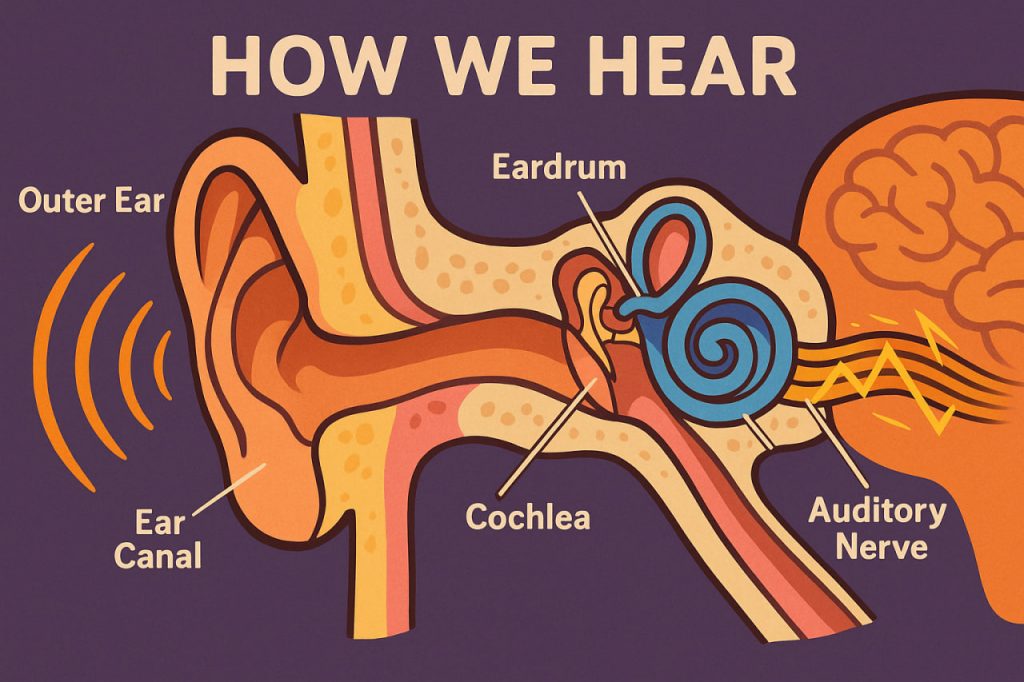Hearing is one of the most extraordinary abilities of the human body—a process so seamless that we rarely stop to think about how it works. Yet behind every note of music, every spoken word, and every whisper lies an intricate biological symphony. Hearing connects us to the world, shapes our emotions, and plays a crucial role in communication and survival. Understanding how we hear reveals not only the complexity of the ear but also the fascinating relationship between sound, the brain, and perception.
What Is Sound?
Sound is a form of energy created by vibrations. When an object vibrates—like a guitar string or a vocal cord—it pushes and pulls the surrounding air particles, forming waves that travel through space. These sound waves move in patterns of compression and rarefaction (high and low pressure). The human ear detects these vibrations within a range of roughly 20 to 20,000 hertz (Hz). The frequency of a sound wave determines its pitch (high or low tone), while the amplitude determines its loudness.
The Outer Ear: Capturing Vibrations
The journey of sound begins at the outer ear, which includes the visible part called the pinna and the ear canal. The pinna acts like a funnel, collecting sound waves and directing them toward the eardrum. The shape of the outer ear helps us locate where sounds come from, distinguishing front from back and left from right. When sound waves reach the eardrum (tympanic membrane), they cause it to vibrate—setting the entire hearing mechanism into motion.
The Middle Ear: Amplifying the Sound
Behind the eardrum lies the middle ear, a tiny air-filled chamber containing the three smallest bones in the human body: the malleus (hammer), incus (anvil), and stapes (stirrup). These bones form a delicate chain that amplifies the eardrum’s vibrations and transmits them to the inner ear. The stapes connects to a small opening called the oval window, which leads into the fluid-filled cochlea. The middle ear also contains the Eustachian tube, which balances air pressure between the inner and outer sides of the eardrum—vital for maintaining clear hearing.
The Inner Ear: Translating Vibrations into Signals
The inner ear is where mechanical sound energy becomes electrical information for the brain. Inside the cochlea—a spiral-shaped organ resembling a snail shell—tiny hair cells line the basilar membrane. As sound vibrations move through the cochlear fluid, these hair cells bend and convert movement into electrical signals. Different hair cells respond to different frequencies—high tones at the cochlea’s base and low tones at its apex. Once converted, these electrical impulses travel through the auditory nerve to the brain’s auditory cortex, where sound is interpreted as music, speech, or noise.
How the Brain Perceives Sound
The brain does not simply “hear” sound; it interprets it. When signals reach the auditory cortex, the brain decodes them into recognizable patterns—like a familiar voice or a melody. The left hemisphere typically processes speech, while the right is more attuned to music and tone. The brain also integrates sound with memory, emotion, and attention, explaining why a certain song can evoke vivid memories or why we instinctively react to danger signals like alarms or crying.
The Balance System and the Ear
The inner ear also houses the vestibular system, responsible for balance and spatial orientation. This system includes three semicircular canals filled with fluid that detect motion and head position. Together, hearing and balance form a unified sensory network that helps us navigate and respond to the environment accurately.
Protecting Our Hearing
While the ear is remarkably sensitive, it is also delicate. Exposure to loud sounds above 85 decibels (dB) can damage hair cells permanently, leading to noise-induced hearing loss. Listening to music at high volume, working in noisy environments, or experiencing sudden explosions can all harm the inner ear. Regular breaks, ear protection, and safe listening habits are essential for preserving hearing health throughout life.
Interesting Facts
- The smallest bone in the human body—the stapes—is smaller than a grain of rice.
- Sound travels faster in water than in air, but our ears are designed primarily for air vibrations.
- The brain can identify where a sound comes from within milliseconds.
- Once damaged, inner ear hair cells cannot regenerate, which is why hearing loss is often permanent.
- The cochlea contains about 15,000 hair cells, each responding to a specific frequency range.
Glossary
- Sound Wave – A vibration that travels through air or another medium and can be heard when it reaches the ear.
- Hertz (Hz) – The unit of frequency, representing cycles per second of a sound wave.
- Eardrum (Tympanic Membrane) – A thin membrane that vibrates when sound waves reach it.
- Cochlea – A spiral-shaped organ in the inner ear responsible for converting sound vibrations into nerve impulses.
- Hair Cells – Sensory cells inside the cochlea that detect sound and send electrical signals to the brain.
- Auditory Nerve – The nerve that carries sound information from the inner ear to the brain.
- Amplitude – The height of a sound wave, determining how loud it sounds.
- Frequency – The number of sound wave cycles per second, determining the pitch of a sound.
- Vestibular System – The sensory system in the inner ear responsible for balance and spatial orientation.
- Decibel (dB) – The unit used to measure sound intensity.


